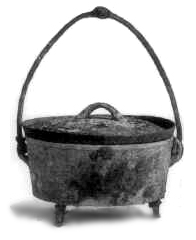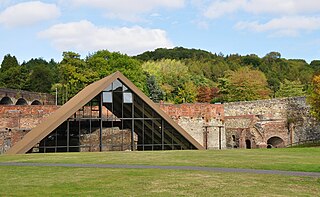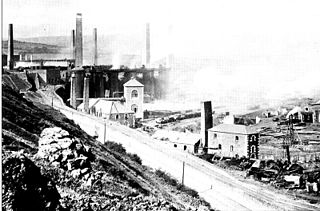Related Research Articles

The Bessemer process was the first inexpensive industrial process for the mass production of steel from molten pig iron before the development of the open hearth furnace. The key principle is removal of impurities from the iron by oxidation with air being blown through the molten iron. The oxidation also raises the temperature of the iron mass and keeps it molten.

Wrought iron is an iron alloy with a very low carbon content in contrast to that of cast iron. It is a semi-fused mass of iron with fibrous slag inclusions, which give it a wood-like "grain" that is visible when it is etched, rusted, or bent to failure. Wrought iron is tough, malleable, ductile, corrosion resistant, and easily forge welded, but is more difficult to weld electrically.

Cast iron is a class of iron–carbon alloys with a carbon content more than 2%. Its usefulness derives from its relatively low melting temperature. The alloy constituents affect its color when fractured; white cast iron has carbide impurities which allow cracks to pass straight through, grey cast iron has graphite flakes which deflect a passing crack and initiate countless new cracks as the material breaks, and ductile cast iron has spherical graphite "nodules" which stop the crack from further progressing.

A blast furnace is a type of metallurgical furnace used for smelting to produce industrial metals, generally pig iron, but also others such as lead or copper. Blast refers to the combustion air being supplied above atmospheric pressure.

A Dutch oven or casserole dish (international) is a thick-walled cooking pot with a tight-fitting lid. Dutch ovens are usually made of seasoned cast iron; however, some Dutch ovens are instead made of cast aluminium, or ceramic. Some metal varieties are enameled rather than being seasoned, and these are sometimes called French ovens. The international name casserole dish is from the French casserole which means "cooking pot". They are similar to both the Japanese tetsunabe and the sač, a traditional Balkan cast-iron oven, and are related to the South African potjie, the Australian Bedourie oven and Spanish cazuela.

Crucible steel is steel made by melting pig iron, iron, and sometimes steel, often along with sand, glass, ashes, and other fluxes, in a crucible. In ancient times steel and iron were impossible to melt using charcoal or coal fires, which could not produce temperatures high enough. However, pig iron, having a higher carbon content and thus a lower melting point, could be melted, and by soaking wrought iron or steel in the liquid pig-iron for a long time, the carbon content of the pig iron could be reduced as it slowly diffused into the iron, turning both into steel. Crucible steel of this type was produced in South and Central Asia during the medieval era. This generally produced a very hard steel, but also a composite steel that was inhomogeneous, consisting of a very high-carbon steel and a lower-carbon steel. This often resulted in an intricate pattern when the steel was forged, filed or polished, with possibly the most well-known examples coming from the wootz steel used in Damascus swords. The steel was often much higher in carbon content and in quality in comparison with other methods of steel production of the time because of the use of fluxes. The steel was usually worked very little and at relatively low temperatures to avoid any decarburization, hot short crumbling, or excess diffusion of carbon; just enough hammering to form the shape of a sword. With a carbon content close to that of cast iron, it usually required no heat treatment after shaping other than air cooling to achieve the correct hardness, relying on composition alone. The higher-carbon steel provided a very hard edge, but the lower-carbon steel helped to increase the toughness, helping to decrease the chance of chipping, cracking, or breaking.

Coalbrookdale is a village in the Ironbridge Gorge in Shropshire, England, containing a settlement of great significance in the history of iron ore smelting. It lies within the civil parish called the Gorge.

A bloomery is a type of metallurgical furnace once used widely for smelting iron from its oxides. The bloomery was the earliest form of smelter capable of smelting iron. Bloomeries produce a porous mass of iron and slag called a bloom. The mix of slag and iron in the bloom, termed sponge iron, is usually consolidated and further forged into wrought iron. Blast furnaces, which produce pig iron, have largely superseded bloomeries.

An ironworks or iron works is an industrial plant where iron is smelted and where heavy iron and steel products are made. The term is both singular and plural, i.e. the singular of ironworks is ironworks.

Abraham Darby, in his later life called Abraham Darby the Elder, now sometimes known for convenience as Abraham Darby I, was a British ironmaster and foundryman. Born into an English Quaker family that played an important role in the Industrial Revolution, Darby developed a method of producing pig iron in a blast furnace fuelled by coke rather than charcoal. This was a major step forward in the production of iron as a raw material for the Industrial Revolution.

The Cyfarthfa Ironworks were major 18th- and 19th-century ironworks in Cyfarthfa, on the north-western edge of Merthyr Tydfil, in South West Wales.

Puddling is the process of converting pig iron to bar (wrought) iron in a coal fired reverberatory furnace. It was developed in England during the 1780s. The molten pig iron was stirred in a reverberatory furnace, in an oxidizing environment to burn the carbon, resulting in wrought iron. It was one of the most important processes for making the first appreciable volumes of valuable and useful bar iron without the use of charcoal. Eventually, the furnace would be used to make small quantities of specialty steels.

The Butterley Company was an English manufacturing firm founded as Benjamin Outram and Company in 1790. Its subsidiaries existed until 2009.

Ferrous metallurgy is the metallurgy of iron and its alloys. The earliest surviving prehistoric iron artifacts, from the 4th millennium BC in Egypt, were made from meteoritic iron-nickel. It is not known when or where the smelting of iron from ores began, but by the end of the 2nd millennium BC iron was being produced from iron ores in the region from Greece to India, and sub-Saharan Africa. The use of wrought iron was known by the 1st millennium BC, and its spread defined the Iron Age. During the medieval period, smiths in Europe found a way of producing wrought iron from cast iron using finery forges. All these processes required charcoal as fuel.
In metallurgy, refining consists of purifying an impure metal. It is to be distinguished from other processes such as smelting and calcining in that those two involve a chemical change to the raw material, whereas in refining, the final material is usually identical chemically to the original one, only it is purer. The processes used are of many types, including pyrometallurgical and hydrometallurgical techniques.
William Wood (1671–1730) was an English hardware manufacturer, ironmaster, and mintmaster, notorious for receiving a contract to strike an issue of Irish coinage from 1722 to 1724. He also struck the 'Rosa Americana' coins of British America during the same period. Wood's coinage was extremely unpopular in Ireland, occasioning controversy as to its constitutionality and economic sense, notably in Jonathan Swift's Drapier's Letters. The coinage was recalled and exported to the colonies of British America. Subsequently, Wood developed a novel but ineffective means of producing iron, which he exploited as part of a fraudulent investment scheme.
Anthony Bacon was an English-born merchant and industrialist who was significantly responsible for the emergence of Merthyr Tydfil as the iron-smelting centre of Britain.
Charles Wood was an English ironmaster and one of the inventors of the potting and stamping method of making wrought iron from pig iron.

The Wundowie charcoal iron and wood distillation plant manufactured pig iron between 1948 and 1981 and wood distillation products between 1950 and 1977, at Wundowie, Western Australia.
The Heaton process is one of the 18th century processes for refining pig iron without the use of charcoal.
References
- ↑ Jones, Edgar (10 November 1987). A History of GKN: Volume 1: Innovation and Enterprise, 1759-1918. Palgrave Macmillan UK. ISBN 134906629X . Retrieved 26 September 2022.
- ↑ Hayman, Richard; Horton, Wendy; White, Shelley (1999). Archaeology and Conservation in Ironbridge. Council for British Archaeology. ISBN 1902771052 . Retrieved 26 September 2022.
- ↑ MacLeod, Christine (9 May 2002). Inventing the Industrial Revolution: The English Patent System, 1660-1800. Cambridge University Press. p. 179. ISBN 0521893992 . Retrieved 26 September 2022.